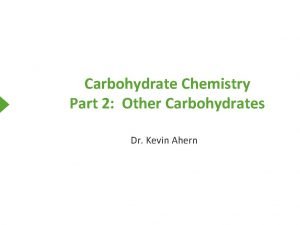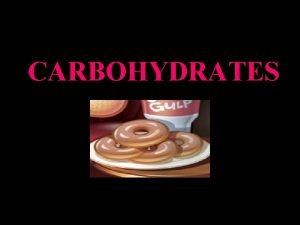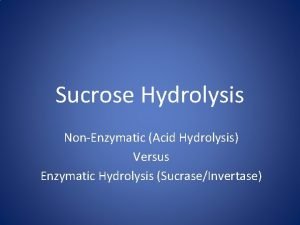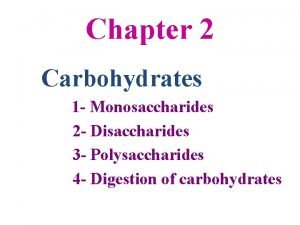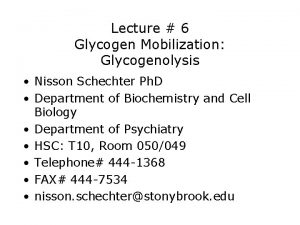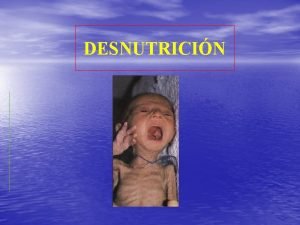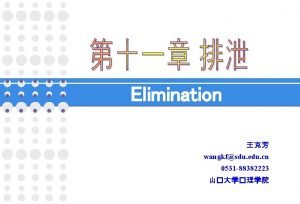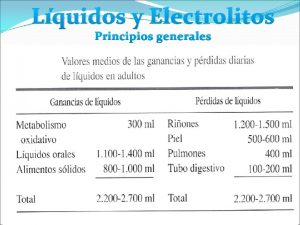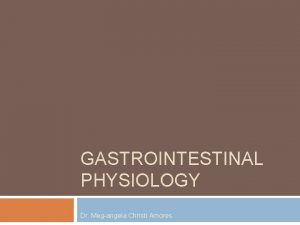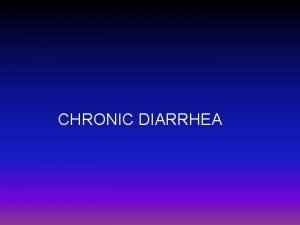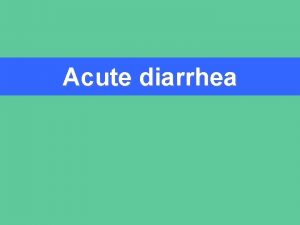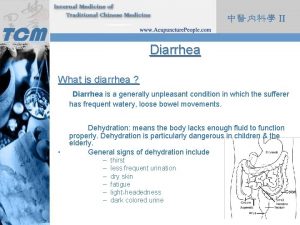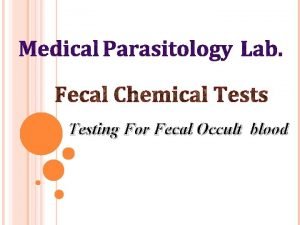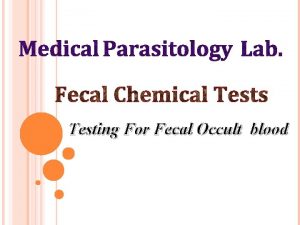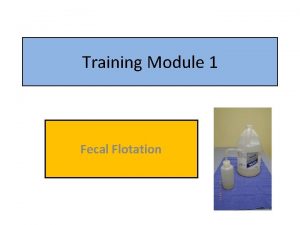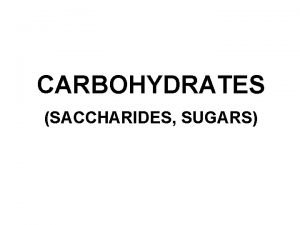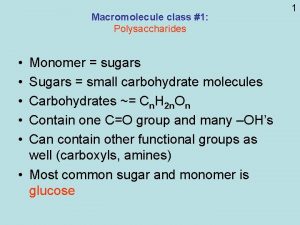Fecal Fat Testing Reducing Sugars Diarrhea Diarrhea is















- Slides: 15

Fecal Fat Testing & Reducing Sugars

Diarrhea • Diarrhea is defined as an increase in daily stool weight above 200 with increased liquidity and frequency of more than three times per day. • Diarrhea classification can be based on four factors: duration of the illness, mechanism, severity, and stool characteristics. • Diarrhea lasting less than 4 weeks is defined as acute, and diarrhea persisting for more than 4 weeks is termed chronic diarrhea. • The major mechanisms of diarrhea are secretory, osmotic, and altered motility. • The laboratory tests used to differentiate these mechanisms are fecal electrolytes (fecal sodium, fecal potassium), fecal osmolality, and stool p. H. Raed Z. Ahmed, Medical Parasitology Lab. , 2012

Continue……. • Secretory Diarrhea: Bacterial, viral, and protozoan infections produce increased secretion of water and electrolytes, which override the reabsorptive ability of the large intestine • Osmotic Diarrhea: Incomplete breakdown or reabsorption of food presents increased fecal material to the large intestine, resulting in the retention of water and electrolytes in the large intestine which in turn results in excessive watery stool. • Altered Motility: Altered motility describes conditions of enhanced motility (hypermotility) or slow motility (constipation). Raed Z. Ahmed, Medical Parasitology Lab. , 2012

Malabsorption & Maldigestion • Malabsorption is defined as the impaired absorption of nutrients by the intestine. • Maldigestion is defined as the impaired digestion of food. • Maldigestion and malabsorption contribute to osmatic diarrhea. • Specific nutrient absorptive disorders: – – Carbohydrate Malabsorption Fat malabsorption/Maldigestion Protein Malabsorption Mineral and Vitamin Malabsorption Raed Z. Ahmed, Medical Parasitology Lab. , 2012

Investigations of Malabsorption Ø Investigations of Carbohydrate Malabsorption: § D- xylose Test § Lactose Intolerance § Stool Reducing Sugar Ø Investigations of Fat Malabsorption: § Fecal Fat Test Ø Investigations of Protein Malabsorption: § Albumin Level § α 1 - antitrypsin Ø Investigations of Mineral and Vitamins Malabsorption: § Stool Electrolyte (Na+, K+) Raed Z. Ahmed, Medical Parasitology Lab. , 2012

Investigation of Carbohydrate Malabsorption Stool Reducing Sugar • This test measures unabsorbed sugars in stool. It is used to evaluate the body's ability to digest carbohydrates, or to absorb nutrients from food and drinks. • Testing for fecal reducing substances detects congenital disaccharidase deficiencies as well as enzyme deficiencies due to nonspecific mucosal injury. • Fecal carbohydrate testing is most valuable in assessing cases of infant diarrhea and may be accompanied by a p. H determination. • The copper reduction test is performed using a Clinitest tablet and one part stool emulsified in two parts water. Raed Z. Ahmed, Medical Parasitology Lab. , 2012

Continue ……. • A result of 0. 5 g/d. L is considered indicative of carbohydrate intolerance. • The Clinitest on stools can distinguish between diarrhea caused by abnormal excretion of reducing sugars and those caused by various viruses and parasites. • Sucrose is not detected by the Clinitest method because it is not a reducing sugar. • A positive result would be followed by more specific serum carbohydrate tolerance tests, the most common being the D-xylose test for malabsorption and the lactose tolerance test for maldigestion. Raed Z. Ahmed, Medical Parasitology Lab. , 2012

Continue ……. • The Fecal Reducing Substances test is performed in a laboratory, on a sample of stool as small as 5 grams. • Unfortunately this sample needs to be delivered to the laboratory ASAP, preferably within 1 hour. • This is because lactose (or other sugars) in the stool will normally be broken down by chemical processes within 2 -4 hours after the specimen is produced • Adults and Children : – Normal: = 0. 25 g/dl – Suspicious: 0. 25 -0. 5 g/dl – Abnormal: > 0. 5 g/dl Raed Z. Ahmed, Medical Parasitology Lab. , 2012

Investigation of Fat Malabsorption • Steatorrhea: is the presence of excess fat in feces, Stools • • may also float due to excess lipid, have an oily appearance and be especially foul-smelling. There is increased fat excretion, which can be measured by determining the fecal fat level. Possible biological causes can be lack of bile acids, defects in pancreatic enzymes “maldigestion”, and defective mucosal cells “malabsorption”. The absence of bile acids will cause the feces to turn gray or pale. Quantitative fecal fat analysis is used as a confirmatory test for steatorrhea Raed Z. Ahmed, Medical Parasitology Lab. , 2012

Investigation of Fat Malabsorption Fecal Fat Test • Fecal fat testing can be done by either qualitative microscopy method or quantitative methods. 1. Qualitative Microscopy Method: – Is the simplest form of the fecal fat test, a random fecal specimen is submitted to the hospital laboratory and examined under a microscope after staining with a Sudan III dye. Visible amounts of fat indicate some degree of fat malabsorption. – The staining procedure consists of two parts, the neutral fat stain and the split fat stain. Raed Z. Ahmed, Medical Parasitology Lab. , 2012

Qualitative Microscopy Fat Testing • Neutral fats stain are readily stained by Sudan III and appear as large orange-red droplets, often located near the edge of the coverslip. • Observation of more than 60 large orange-red droplets/HPF can be indicative of steatorrhea. • The split fat stain representing total fat content can provide a better indication. • The breakdown of neutral fats by bacterial lipase and the spontaneous hydrolysis of neutral fats may lower the neutral fat count. • Observation of more than 100 large orange-red droplets/HPF can be indicative of steatorrhea • This also precludes the comparison of the two slide tests to determine whether maldigestion or malabsorption is causing steatorrhea Raed Z. Ahmed, Medical Parasitology Lab. , 2012

Quantitative Fat Testing • Quantitative fecal fat analysis is used as a confirmatory test for steatorrhea. • Quantitative fecal analysis requires the collection of at least a 3 day specimen. • The patient must also maintain a regulated intake of fat (100 g/dl) prior to and during the collection period. • Refrigerating the specimen prevents any bacterial degradation. • The method routinely used for fecal fat measurement is the Van de Kamer titration, although gravimetric methods are available. • Fecal lipids are converted to fatty acids and titrated to a neutral endpoint with sodium hydroxide. Raed Z. Ahmed, Medical Parasitology Lab. , 2012

Continue ……. • The fat content is reported as grams of fat or the coefficient of fat retention per 24 hours. • The coefficient of fat = ( dietary Fat – Fecal Fat ) dietary Fat X 100 • Normal values based on a 100 g/dl intake are 1 to 6 g/dl or a coefficient of fat retention of at least 95%. • Although the Van de Kamer titration is the gold standard for fecal fat, the acid Steatocrit is a rapid test to estimate the amount of fat excretion. • It is similar to the microhematocrit test. Raed Z. Ahmed, Medical Parasitology Lab. , 2012

Continue ……. • The acid steatocrit is a reliable tool to monitor a patient’s response to therapy and screen for steatorrhea in pediatric populations. • Acid steatocrit % = fatty layer length in cm X 100 (fatty layer length in cm + solid layer length) • An acid steatocrit value less than 31% was considered normal while a value greater than 31% indicated steatorrhea in adults. • Acid steatocrit is higher in infants and droppped with age. An acid steatocrit of less than 10% is indicative of steatorrhea in children. Raed Z. Ahmed, Medical Parasitology Lab. , 2012

Continue ……. • • • Calculate the fecal fat in grams per 24 hours. In adult: Fecal fat in g/24 hrs. = [0. 45 X acid steatocrit %] – 0. 43 In children up to 15 years: Fecal fat in g/24 hrs. = [0. 1939 X acid steatocrit %] – 0. 2174 Raed Z. Ahmed, Medical Parasitology Lab. , 2012
 Glucose seliwanoff test
Glucose seliwanoff test Non reducing sugar vs reducing sugar
Non reducing sugar vs reducing sugar Fehling's test sucrose
Fehling's test sucrose Glucose standard curve
Glucose standard curve Basic monosaccharides
Basic monosaccharides Stool reducing sugar test procedure
Stool reducing sugar test procedure Reducing and non reducing end of glycogen
Reducing and non reducing end of glycogen Clasificacion de waterlow desnutricion
Clasificacion de waterlow desnutricion Fecal impaction
Fecal impaction Electrolitos
Electrolitos Fecal
Fecal Hemosure ifob test directions
Hemosure ifob test directions Babcock tissue forceps uses
Babcock tissue forceps uses Fecal matter
Fecal matter Fecal matter
Fecal matter Oral-fecal
Oral-fecal

